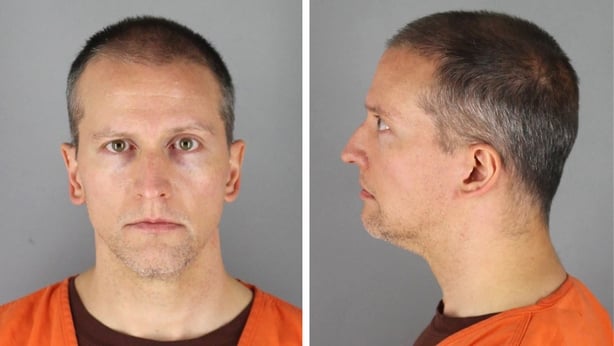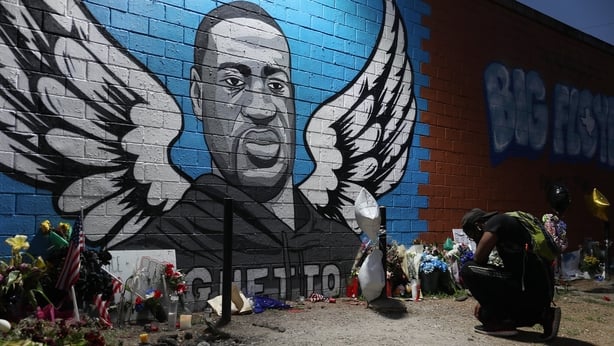Paramedics who treated George Floyd said he was not breathing and had no pulse when they arrived at the scene of his deadly arrest last May, in testimony today at the murder trial of former policeman Derek Chauvin.
"In lay terms, I thought he was dead," Derek Smith, one of the paramedics, told the jury. By the time Smith arrived, Chauvin had been pressing his knee into the neck of Floyd, a 46-year-old black man in handcuffs, for about nine minutes, a scene that ignited global protests against police brutality.
Chauvin, 45, has pleaded not guilty to murder and manslaughter charges. In a central dispute of the trial, his lawyers have argued that Floyd's death, which the county medical examiner ruled was a homicide at the hands of police, was really an overdose caused by the fentanyl found in his blood at autopsy.
Prosecutors from the Minnesota attorney general's office have told the jury they will hear evidence to contradict this, including testimony from his girlfriend about his drug tolerance, and that Floyd's drug use is irrelevant to the charges against Chauvin.

Here are some key moments from the fourth day of witness testimony:
Courteney Ross, George Floyd's girlfriend
Courteney Ross, 45, was the first person who personally knew Floyd to testify in the trial, and with a heart-shaped brooch pinned to her black jacket she tearfully spoke of their romance and their shared struggles with opioid addiction.
"It's one of my favourite stories to tell," Ms Ross said, smiling toward the jury, when asked by a prosecutor how she first met Mr Floyd in August 2017 at a Salvation Army homeless shelter, where he worked as a security guard.
She was waiting in the lobby to see the father of her son, tired after closing up the coffee shop where she worked. Mr Floyd approached her.
"Floyd has this great, deep, southern voice, raspy," she said, "and he was, like, 'Sis, you ok, sis?'"
He sensed she felt alone, and offered to pray with her.
"It was so sweet," she said. "At the time I had lost a lot of faith in God."
They had their first kiss in the lobby that night and, but for the occasional break after a lovers' quarrel, were together until his death, she said.
They took walks in the parks and around the lakes of Minneapolis, which was still new to the Texas-raised George Floyd, and ate out a lot: "He was a big man," she said, describing his daily weightlifting, "and it look a lot of energy to keep him going." She said he adored his mother, who died in 2018, and his two young daughters.

At times they took prescribed painkillers. At other times they illegally obtained opioids. Sometimes they shook the habit, sometimes they relapsed.
"Addiction, in my opinion, is a lifelong struggle," she said. "It's not something that comes and goes, it's something I'll deal with forever."
Chauvin's lead lawyer, Eric Nelson, asked Ms Ross many questions in cross-examination about how the couple got their drugs and an episode where Mr Floyd took himself to a hospital emergency room for what proved to be a non-fatal overdose.
She said she thought Mr Floyd sometimes bought pills from Morries Hall, who was sat in the car next to Mr Floyd in the front passenger seat when police arrived last May.
Mr Nelson has subpoenaed Mr Hall to testify when the defence presents its case, and has told the jury that Hall and a woman in the car would tell them that they saw Mr Floyd swallow two pills before police arrived on 25 May and that he fell into a deep sleep.
Through a lawyer, Mr Hall said he would invoke his constitutional right against self-incrimination if called to testify, and asked Hennepin County District Judge Peter Cahill to quash the subpoena.
We need your consent to load this rte-player contentWe use rte-player to manage extra content that can set cookies on your device and collect data about your activity. Please review their details and accept them to load the content.Manage Preferences
Seth Bravinder and Derek Smith, paramedics who treated George Floyd
George Floyd appeared to be not breathing and had no pulse when Seth Bravinder and Derek Smith of Hennepin Emergency Medical Services arrived in an ambulance outside Cup Foods, where Mr Floyd was suspected of passing a fake $20 bill earlier in the evening.
They had to ask Chauvin and other officers to move.
"They were still on top of him," Mr Bravinder told the jury. His first thought was that some kind of struggle was going on, but it quickly became clear that Mr Floyd was limp.
Mr Smith could not find a pulse, and his pupils were dilated. Mr Bravinder cradled Mr Floyd's head as they transferred him to a gurney. They stopped two blocks away to continue resuscitation efforts on Floyd.
Mr Bravinder saw a flat line on the heart monitor.
"It's not a good sign," Mr Bravinder said.
Jurors were shown images of paramedics checking Floyd inside the ambulance, congealed blood below his nose and red scrape marks on his left shoulder. The paramedics could not revive him.

